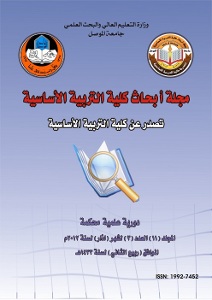The Distribution of Parasitic Intestinal Infection andits Relation with the Type of Food in the Children of two nursery Schools in Mosul City
Abstract
1220 flotation method . 600 49% . 35% 30% 4.8% . Giardia lamblia 15.8% Entamoeba histolytica 13.3% Endolemax nana 1.17% . Enterobius vermicularis 3.3% Ascaris lumbricoides 0.8% Taenia saginata 0.7% . Giardia lamblia Entamoeba histolytica (22.3% 21.6% ) Endolemax nana (32.2%) Enterobius vermicularis Ascaris lumbricoides Taenia saginata (28.6% 28.6% 57.1%) .In this study examination of 1220 fecal samples from children under five years was performed; these children stay in two nursery schools in AL-Zahra region in Mosul city. The samples were examined directly and by using the Flotation methodThe percentage of intestinal infection was 49% , single, double and triple infection of intestinal parasites were recorded. The results of single infection of intestinal parasites was 35% included protozoa 30% and worms 4.8%. There is high infection percentage with the cysts of Giardia lamblia , viz. 15.8%, then cysts of Entamoeba histolytica was 13.3%, and finally cysts of Endolimax nana was 1.17%. As concerning the worms,it included the eggs of Enterobius vermicularis 3.3%, while the Ascaris lumbricoides eggs reached the percentage of 0.8%. Finally the eggs of Taenia saginata showed less infection which was approximately 0.7%.Generally, higher percentage of infection with intestinal protozoa were shown with Giardia lamblia, Entamoeba histolytica in June (21.6%, 22.3%, respectively) but Endolimax nana recorded 32.2% in May, while the intestinal Helminths give higher percentage of infection in June which reached 28.6%, 28.6% and 57.1% for Enterobius vermicularis, Ascaris lumbricoides and Taenia saginata,respectively .
